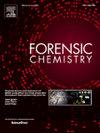利用气相色谱-质谱法分析沙质壤土中神经毒剂衍生的乙基和频哪醇甲基膦酸的两种苄基化策略评估
IF 2.6
3区 医学
Q2 CHEMISTRY, ANALYTICAL
引用次数: 0
摘要
尽管《化学武器公约》禁止使用神经毒剂,但神经毒剂仍被用于攻击军事和民用目标。由于其反应活性高,NAs 很容易降解为膦酸,这使其成为检查假定使用过 NA 的区域的重要标记。在这项工作中,我们评估了利用苄基化对乙基甲基膦酸和频哪醇甲基膦酸(分别为 VX 和索曼的降解产物)进行改性的方法,以便利用气相色谱-质谱法在土壤基质中有效检测出 10 ∼ μg/g 和 1 ∼ μg/g 的甲基膦酸。选择砂质壤土(Sandy Loam,SL)作为土壤基质是因为它无处不在,成分复杂,粘土中含有二氧化硅颗粒,而且有机物含量较低。在这项研究中,我们证明了通过苄基溴进行苄基化,苄基化-EMPA 的 LOD = 25.6 ng/mL,苄基化-PMPA 的 LOD = 30.1 ng/mL。这比使用对甲氧基苄基三氯乙酰亚氨酸来提供稳定的膦酸酯衍生物进行分析更有优势。本研究探索了对甲氧基苄基化的碱修饰程序,结果显示对甲氧基苄基化-EMPA 的检测限为 29.1 纳克/毫升,对甲氧基苄基化-PMPA 的检测限为 39.8 纳克/毫升。这两种苄基化途径(苄基溴和对甲氧基苄基三氯乙酰亚氨酸)都可用于生成膦酸衍生物,从而进一步确认调查场景中土壤样本中的这些索曼和 VX 降解产物。本研究首次将苄基化方法用于分析酸性硅基 SL 土壤中的这些 NA 标记物。本文章由计算机程序翻译,如有差异,请以英文原文为准。

Assessment of two benzylation strategies for the analysis of nerve-agent derived ethyl- and pinacolyl methyl phosphonic acids in sandy loam soil by GC–MS
Despite their prohibition by the Chemical Weapons Convention, nerve agents (NAs) remain in use against military and civilian targets. Due to their high reactivity, NAs readily degrade to phosphonic acids, making them important markers in the inspection of areas of presumed NA use. In this work, we assess the use of benzylation to modify ethyl- and pinacolyl methylphosphonic acids, degradation products of VX and Soman respectively, for their efficient detection in a soil matrix at ∼10 and ∼1 μg/g using GC–MS. The soil matrix, Sandy Loam (SL), was chosen for its ubiquitous nature, complex composition with silica particles embedded in clay, and low organic content. In this study, we demonstrate that benzylation via benzyl bromide yields a LOD = 25.6 ng/mL for benzylated-EMPA and LOD = 30.1 ng/mL for benzylated-PMPA. This is superior to the use of p-methoxybenzyl trichloroacetimidate in providing stable phosphonic acid ester derivatives for analysis. A base-modified procedure for p-methoxybenzylation was explored in this study yielding a LOD = 29.1 ng/mL for p-methoxybenzylated-EMPA and LOD = 39.8 ng/mL for p-methoxybenzylated-PMPA. Both benzylation pathways (benzyl bromide and p-methoxybenzyl trichloroacetimidate) can be used to yield phosphonic acid derivatives that provide further confirmation of these Soman and VX degradation products in soil samples in investigative scenarios. The work herein represents the first application of benzylation methods for the analysis of these NA markers in the acidic, silicon-based SL soil.
求助全文
通过发布文献求助,成功后即可免费获取论文全文。
去求助
来源期刊

Forensic Chemistry
CHEMISTRY, ANALYTICAL-
CiteScore
5.70
自引率
14.80%
发文量
65
审稿时长
46 days
期刊介绍:
Forensic Chemistry publishes high quality manuscripts focusing on the theory, research and application of any chemical science to forensic analysis. The scope of the journal includes fundamental advancements that result in a better understanding of the evidentiary significance derived from the physical and chemical analysis of materials. The scope of Forensic Chemistry will also include the application and or development of any molecular and atomic spectrochemical technique, electrochemical techniques, sensors, surface characterization techniques, mass spectrometry, nuclear magnetic resonance, chemometrics and statistics, and separation sciences (e.g. chromatography) that provide insight into the forensic analysis of materials. Evidential topics of interest to the journal include, but are not limited to, fingerprint analysis, drug analysis, ignitable liquid residue analysis, explosives detection and analysis, the characterization and comparison of trace evidence (glass, fibers, paints and polymers, tapes, soils and other materials), ink and paper analysis, gunshot residue analysis, synthetic pathways for drugs, toxicology and the analysis and chemistry associated with the components of fingermarks. The journal is particularly interested in receiving manuscripts that report advances in the forensic interpretation of chemical evidence. Technology Readiness Level: When submitting an article to Forensic Chemistry, all authors will be asked to self-assign a Technology Readiness Level (TRL) to their article. The purpose of the TRL system is to help readers understand the level of maturity of an idea or method, to help track the evolution of readiness of a given technique or method, and to help filter published articles by the expected ease of implementation in an operation setting within a crime lab.
 求助内容:
求助内容: 应助结果提醒方式:
应助结果提醒方式:


